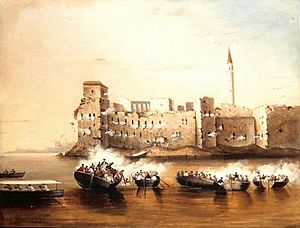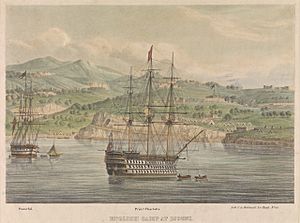Egyptian–Ottoman War (1839–1841) facts for kids
Quick facts for kids Second Egyptian–Ottoman War |
|||||||||
|---|---|---|---|---|---|---|---|---|---|
| Part of the campaigns of Muhammad Ali of Egypt | |||||||||
|
|||||||||
| Belligerents | |||||||||
Allies: |
Allies: |
||||||||
| Commanders and leaders | |||||||||
The Second Egyptian–Ottoman War was a conflict that took place from 1839 to 1841. It was mostly fought in a region called Syria. Sometimes, people call it the Second Syrian War.
This war happened because the Ottoman Empire wanted to take back lands they had lost. These lands were taken by Muhammad Ali, who was a powerful ruler of Egypt. The Ottomans invaded Syria, but they lost a big battle called the Battle of Nezib. This made it seem like the Ottoman Empire might fall apart.
After the battle, the Ottoman navy even surrendered to Muhammad Ali. Because of this, powerful European countries like Britain, Austria, and Russia stepped in. They wanted to force Egypt to agree to a peace treaty. From September to November 1840, British and Austrian ships blocked Egypt's sea routes. They also took over cities like Beirut and Acre. Finally, in November 1840, an agreement was made. Muhammad Ali gave up his claims to Syria and returned the Ottoman fleet. In return, he and his sons were recognized as the official rulers of Egypt.
Contents
Why the War Started
This war was the peak of a long struggle between the Ottoman Empire and Muhammad Ali. Muhammad Ali was the ruler, or Pasha, of Egypt. This conflict was so serious that it threatened to make the whole Levant region unstable.
On June 24, 1839, an Ottoman army was defeated in Syria. Muhammad Ali's general, Ibrahim Pasha, led the victory at the Battle of Nezib. This win gave Muhammad Ali control over all of Syria. It even made it seem like he might take over Constantinople, the Ottoman capital.
Just a few days after the battle, the Ottoman Sultan, Mahmud II, died. His 16-year-old son, Abdülmecid, became the new Sultan. Also, the Ottoman navy switched sides and joined Muhammad Ali. Britain, Russia, and Austria had promised to support the Ottoman Empire. They wanted to make Muhammad Ali leave Syria. Muhammad Ali, however, had the support of France and Spain.
The new Sultan's advisors tried to solve the problem by offering Syria to Muhammad Ali. But the ambassadors from Britain, Austria, and Russia made them change their minds. They insisted the Ottomans stand firm against Muhammad Ali. There was even a chance of war with France. France hoped Muhammad Ali's success would increase its influence in the Middle East.
Key Battles and Events
In June 1840, Admiral Sir Robert Stopford commanded the British navy in the Mediterranean Sea. He sent Commodore Charles Napier with a small group of ships to the coast of Syria. Napier was ordered to go to Beirut. His goal was to make the Egyptian forces leave the area. The situation was very tense, so Napier acted quickly and decisively.
On August 11, 1840, Napier's ships arrived near Beirut. He told Suleiman Pasha, Muhammad Ali's governor, to leave the town and Syria. Soon after, the local people in Syria started to rebel against Muhammad Ali's army. Napier had only a small force. He couldn't do much against 15,000 Egyptian soldiers until September. That's when Admiral Stopford's ships joined him.
The war officially began on September 11. Napier's ships attacked Beirut with cannons. They also landed 1,500 Turkish soldiers and Marines at Jounieh. These forces fought against Ibrahim's army. The local revolt stopped Ibrahim from doing much more than trying to hold onto the cities along the coast.
Battles at Sidon and Boharsef

The main army commander, Sir Charles Smith, became ill. So, Napier was put in charge of the land forces. He successfully attacked a group of Albanian soldiers at Nahr-el-Kelb. Then, with British, Turkish, and Austrian ships, he attacked Sidon on September 26. His troops landed and quickly took the city. Sidon surrendered in just two days.
Napier then prepared to attack Egyptian positions in the mountains at Boharsef. But he received an order to step down from leading the land forces. Brigadier-General Smith had recovered and was now in charge of the Turkish army too. Napier decided to ignore the order and continued his attack against Ibrahim's army. The fighting on October 9 was very fierce, but Napier's forces won. After this victory, Napier handed over command to Smith. Meanwhile, the Egyptians had left Beirut on October 3.
Attack on Acre
The fleet was then ordered to take back Acre. This was the last coastal city still held by the Egyptians. Admiral Stopford's fleet, along with Austrian and Turkish ships, moved into position on November 3-4. They started firing at 2:00 PM. The ships anchored closer to the shore than expected, about 450–800 meters away. Because of this, the Egyptian cannons fired too high, missing the ships.
The ships' cannons were very accurate. This was thanks to new training from the Royal Navy's gunnery school, HMS Excellent. The Egyptians couldn't fix their aim. Their cannons were destroyed by direct hits or by falling walls. At 4:20 PM, a shell hit the main gunpowder storage in the city. It exploded, killing 1,100 men. The cannons on shore stopped firing. That night, the city was taken. The British had very few losses, with 18 men killed and 41 wounded. The ships had fired 48,000 cannonballs.
What Happened Next
Muhammad Ali's power quickly collapsed. The Allies didn't want complete chaos in Egypt. So, Admiral Stopford sent Napier to command the ships at Alexandria and watch the situation. Napier acted on his own again. He arrived outside Alexandria with some of his ships on November 25 and started a blockade.
Without asking his Admiral or the British government, Napier personally made a peace deal with Muhammad Ali. He promised Muhammad Ali and his family would rule Egypt forever. He also promised to help Ibrahim's trapped army return to Alexandria. In return, Muhammad Ali had to give up all claims to Syria, obey the Ottoman Sultan, and return the Ottoman fleet.
Admiral Stopford and the British ambassador were very angry about this deal. Stopford immediately said it was not valid. Several Allied countries also said it was void. Even though Napier was friends with Lord Palmerston, a powerful British leader, the British government first rejected the agreement. However, the official treaty that was later signed and confirmed by the Sultan used Napier's original deal as its main basis. It only changed a few small things.


